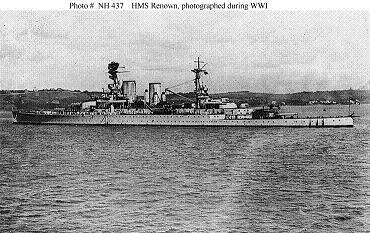![]() The Pacific War Online Encyclopedia
The Pacific War Online Encyclopedia
|
| Previous: Battle class, British destroyers | Table of Contents | Next: Battle Damage Repair Ships |

Naval Historical Center #NH-437
Battle cruisers were large ships designed to scout
for the
battle line or to raid or protect merchant shipping. They
typically had
displacements similar to battleships,
but with a
slightly less powerful main battery and considerably less armor
protection, the
latter being sacrificed in exchange for high speed (30+ knots.) They
were designed at a time when the newly introduced APC shells raised
serious questions about whether heavy side armor was of much use at
likely battle ranges. Battle cruisers were armored only against HE
shells and relied on speed for their protection against APC shells.
However, improvements in fire control meant that engagements took place at greater ranges than anticipated, and at the Battle of Jutland in the First World War, battle cruisers proved vulnerable because of their lighter protection. The British attributed the loss of several battle cruisers to poor turret design that allowed turret hits to set off magazines. While it was true that the British had unsafe shell handling machinery and used a powder formula that was too volatile, the proper lesson was that battle cruisers could not stand up against battleships.
The British retained some battle cruisers after the war, and one of these, the Hood, was destroyed by a magazine explosion in its encounter with the German battleships Bismarck in spite of modernization. Another battle cruiser, Repulse, was sunk by Japanese torpedo bombers off Malaya in the first days of the Pacific war. This was less a reflection on its design than on the hopelessness of the tactical situation.
The United States never completed a battle cruiser, although two keels were laid down prior to the Washington Conference. The hulls were converted to the Lexington-class fleet carriers instead. The large cruisers of the Alaska class were not true battle cruisers, and it is unclear what role these expensive ships were expected to fill.
Long before war broke out, the Japanese had
converted their four battle cruisers of the Kongo
class to fast battleships. However, their guns and armor protection
remained rather light for a true battleship, and Kirishima proved no match for Washington at the Naval Battle
of Guadalcanal.
Battle cruisers were largely obsolete by the time of the Second World War, largely because advances in hull form, power plants, and propulsion had made it possible to achieve battle cruiser speeds with a true battleship. For example, the Iowas were as fast as any battle cruiser, but their armament and armor protection was as good as any other U.S. battleship.
References
Friedman (2008)The Pacific War Online Encyclopedia © 2006-2007, 2011-2013 by Kent G. Budge. Index